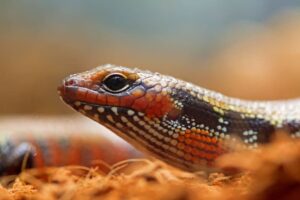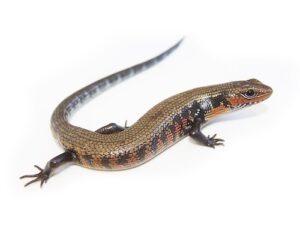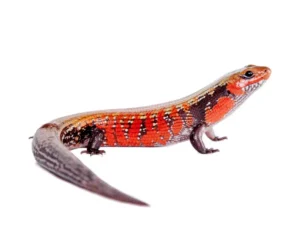If you’re considering adding a fire skink to your reptile collection, one of the key aspects to understand is their size. So, how big do fire skinks get? These vibrant lizards, known for their striking colors and lively personalities, typically reach a length of about 8 to 12 inches from snout to tail.
Their size makes them a manageable yet impressive pet, fitting well into various terrarium setups. In this guide, we’ll delve into their growth patterns, ideal habitat sizes, and what you need to know to ensure they thrive as they grow.
Why knowing their size is important for pet owners and enthusiasts

Understanding how big fire skinks get is crucial for both current and prospective pet owners for several reasons:
- Proper Housing: Knowing their adult size helps in choosing the right size of terrarium. Fire skinks need enough space to move around comfortably, and an appropriately sized habitat is essential for their well-being. A tank that’s too small can lead to stress and health issues.
- Diet and Nutrition: The size of the skink influences their dietary needs. As they grow, their food requirements change, and understanding their potential size helps in planning a balanced diet that meets their nutritional needs.
- Handling and Interaction: Knowing their adult size helps set realistic expectations for handling and interacting with your skink. Larger skinks may be more challenging to handle, so being prepared for their full size can make the experience more enjoyable and safe for both you and your pet.
- Enclosure Setup: The size of your skink will affect the type and amount of enrichment you should provide. Larger skinks need more space and varied enrichment items like hiding spots and climbing structures to stay active and healthy.
- Health Monitoring: Understanding their growth pattern and adult size allows for better monitoring of their health. Any deviations in size from the expected range can indicate health issues that might require veterinary attention.
Common species and variations with their sizes
Fire skinks, known for their vibrant coloration and striking patterns, come in several species and variations, each with its own size range. Here’s a look at some common species and their typical sizes:
- Egyptian Fire Skink (Feral Sphenopsis:
- Size: Typically grows to about 8-10 inches (20-25 cm) in length.
- Description: One of the most commonly kept fire skinks, the Egyptian fire skink features bright red or orange coloration with contrasting black stripes, making it a popular choice for reptile enthusiasts.
- Banded Fire Skink (Feral Sphenops):
- Size: Generally reaches 10-12 inches (25-30 cm) in length.
- Description: Known for its bold banding patterns and vibrant colors, the banded fire skink displays a mix of reds, oranges, and blacks, creating a striking appearance.
- West African Fire Skink (Feral Sphenops):
- Size: Usually grows to about 8-11 inches (20-28 cm) in length.
- Description: This species often has a more subdued color palette compared to its Egyptian and banded relatives, featuring darker tones with less intense coloration.
- Red Fire Skink (Feral Sphenops):
- Size: Similar in size to the Egyptian fire skink, usually reaching 8-10 inches (20-25 cm).
- Description: As the name suggests, the red fire skink is characterized by its vibrant red coloring, which can be more intense than other species.
Key Points
- Variation in Size: While the sizes listed are typical, individual skinks may vary slightly. Growth can be influenced by factors like diet, habitat, and genetics.
- Habitat and Care: Each species has slightly different habitat needs based on their natural range, so understanding their specific size and care requirements is essential for providing optimal conditions.
Knowing the sizes of different fire skink species helps you prepare an appropriate habitat and care plan, ensuring a comfortable and healthy environment for your pet.
How big do fire skinks get?

Fire skinks typically grow to about 8 to 12 inches (20 to 30 cm) in length from snout to tail. Their size can vary slightly depending on the species and individual factors. Here’s a quick overview:
- Egyptian Fire Skink: Generally 8-10 inches (20-25 cm).
- Banded Fire Skink: Typically 10-12 inches (25-30 cm).
- West African Fire Skink: Usually 8-11 inches (20-28 cm).
- Red Fire Skink: Similar to the Egyptian fire skink, about 8-10 inches (20-25 cm).
Understanding their full size helps in setting up the right habitat and providing appropriate care to ensure they thrive.
Factors Affecting Growth
Several factors can influence how big fire skinks get and how quickly they reach their full size. Here’s a closer look at the key factors:
- Diet and Nutrition:
- Quality of Food: A balanced diet rich in protein, vitamins, and minerals is crucial for optimal growth. Fire skinks typically eat a variety of insects like crickets, mealworms, and roaches.
- Feeding Frequency: Younger skinks may need to be fed more frequently than adults. Proper feeding schedules ensure they get the nutrients they need for healthy growth.
- Temperature and Habitat Conditions:
- Temperature Range: Fire skinks require a specific temperature gradient in their enclosure. Incorrect temperatures can affect their metabolism and growth rate.
- Humidity: Adequate humidity levels are essential for their health. A well-maintained habitat with proper humidity supports better growth and overall well-being.
- Genetics:
- Species and Lineage: Different species and individual genetics play a role in determining their ultimate size. Some species naturally grow larger than others.
- Breeding Lines: Fire skinks from certain breeding lines may exhibit variations in size based on genetic factors.
- Health and Disease:
- Overall Health: Health issues or parasites can affect a skink’s growth. Regular veterinary check-ups and maintaining a clean habitat help prevent health problems that could hinder growth.
- Preventive Care: Proper care and monitoring for signs of illness or stress ensure that your skink grows at a healthy rate.
- Enclosure Size and Environment:
- Space: While the size of the enclosure doesn’t directly affect their growth, a larger, well-maintained habitat can provide a more stimulating environment that supports overall health.
- Enrichment: Providing hiding spots, climbing structures, and other environmental enrichment can promote activity and healthy growth.
- Hydration:
- Water Availability: Ensuring that your skink has constant access to fresh water supports hydration and overall health, which is important for growth.
By managing these factors effectively, you can support your fire skink’s growth and help them reach their full potential in a healthy and thriving environment.
Size in Captivity vs. Wild
Fire skinks often show differences in size depending on whether they are in captivity or the wild. Here’s how their size can vary between these environments:
In the Wild
- Natural Growth: In their natural habitat, fire skinks typically grow to their full size based on their species and environmental conditions. Their growth is influenced by the availability of food, space, and natural conditions such as temperature and humidity.
- Variability: Wild skinks may have slight size variations due to factors like competition for resources and environmental stresses. Their size can be influenced by the richness of their habitat and seasonal changes.
- Average Size: Generally, wild fire skinks reach the upper end of their size range. For example, the Banded Fire Skink might grow up to 12 inches (30 cm) in the wild.
In Captivity
- Controlled Environment: In captivity, fire skinks are provided with consistent food, temperature, and humidity, which can sometimes lead to differences in size compared to their wild counterparts.
- Diet and Care: With a well-managed diet and optimal care, captive fire skinks can reach their full potential size. However, poor diet or inadequate habitat conditions can lead to stunted growth.
- Average Size: Captive skinks might be slightly smaller on average compared to their wild relatives, especially if their environment does not perfectly replicate their natural habitat. For instance, captive Banded Fire Skinks might average closer to 10 inches (25 cm) rather than the full 12 inches (30 cm) they might reach in the wild.
Key Differences
- Growth Factors: In the wild, skinks may face challenges like food scarcity and environmental fluctuations that can affect their growth. In captivity, consistent care can ensure they reach their optimal size, but deviations in care can also impact growth.
- Health and Longevity: Captive skinks, with proper care, often experience fewer health issues and may live longer, potentially reaching their full size more reliably than their wild counterparts.
Understanding these differences can help you provide better care for your fire skink, ensuring they have the best chance to grow to their full potential, whether in captivity or the wild.
Care Tips for Ensuring Healthy Growth

To help your fire skink achieve its full growth potential and stay healthy, follow these essential care tips:
- Provide a Balanced Diet:
- Varied Diet: Feed your fire skink a variety of insects, such as crickets, mealworms, and roaches. This ensures they receive a well-rounded mix of nutrients.
- Supplements: Dust their food with calcium and vitamin supplements to prevent deficiencies and support healthy growth.
- Maintain Proper Temperature and Humidity:
- Temperature Gradient: Create a temperature gradient in the enclosure with a warm basking spot (88-92°F or 31-33°C) and a cooler area (75-80°F or 24-27°C). This allows your skink to regulate its body temperature.
- Humidity: Maintain humidity levels between 50-60%. Use a hygrometer to monitor humidity and mist the enclosure regularly to keep it within the ideal range.
- Ensure Adequate Space:
- Enclosure Size: Choose an appropriately sized terrarium to accommodate your skink’s size and activity level. Larger enclosures offer more space for movement and enrichment.
- Enrichment: Include hiding spots, climbing structures, and substrates that mimic their natural habitat to promote physical activity and mental stimulation.
- Regular Health Check-ups:
- Veterinary Care: Schedule regular check-ups with a reptile veterinarian to monitor your skink’s health and address any issues early.
- Observe Behavior: Watch for signs of illness, such as changes in appetite, lethargy, or abnormal shedding, and seek veterinary advice if needed.
- Provide Clean Water:
- Fresh Water: Ensure your skink has constant access to clean, fresh water. Change the water daily to prevent contamination and promote hydration.
- Proper Lighting:
- UVB Lighting: While not all fire skinks require UVB lighting, providing it can help support their overall health and calcium metabolism. Research the specific needs of your skink species.
- Monitor and Adjust:
- Temperature and Humidity: Regularly check and adjust the temperature and humidity levels in the enclosure to maintain the optimal environment for growth.
- Diet and Behavior: Adjust the diet and feeding schedule based on your skink’s age, size, and activity level to support healthy growth.
By following these care tips, you can help ensure that your fire skink grows to its full potential and enjoys a healthy, active life in captivity.
Conclusion
Understanding how big fire skinks get is key to providing the right care and habitat for these fascinating reptiles. Typically, fire skinks reach 8 to 12 inches (20 to 30 cm) in length, depending on the species and individual factors.
Whether in the wild or captivity, ensuring proper diet, habitat, and care will help your fire skink reach its full size and thrive. So, how big do fire skinks get? With the right conditions, they can grow to be vibrant, healthy adults, making for a captivating addition to your reptile collection.

